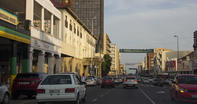Escaping the Toil of Rural Life
A Xhosa family, the Ntlokwana’s, fled the deprivation and scarcity of the rural Eastern Cape for the same reasons so many people move to the city. The mother, Nomavuso, wanted to be closer to her husband, to a source of the household income, to the job market, to doctors, schools and clinics for her little ones.

Like many, she may have wanted to escape the toil of rural life. And her experience is not the exception, even back in the 1930s. Around the globe, particularly in the developing world, people have been trailing into cities in the past few decades, in search of that urban Shangri-La, and the trend is going to continue.
By 2007, for the first time in human history, over half the world’s population got up to breakfast each day somewhere within the folds of a cityscape. By 2050, the world’s population is expected to climb to between 9 and 10 billion, with most of that growth likely to happen in the developing world, in cities.
Some 3 or so billion additional people, according to the United Nations, will join the global pond of Homo sapiens, all adding to those already living within the confines of these sprawling mega-tropolises. Urbanisation in Africa will be higher than the global average, predicts UN-Habitat in its State of the World’s Cities Report for 2006/2007. By 2030, the developing world’s cities will hold 4 billion people – close to half the world’s entire population – by which time over half of Africa’s population will have put down their roots in cities.
Urbanisation Rates in Southern Africa
Sub-Saharan Africa’s rate of urban migration is already two times that of the global trend, making it the fastest-urbanising region on the planet. Already, some 40% of people in the SADC are in cities (Botswana and South Africa are ahead of the curve, with 60% of their populations urbanised), and in less than two decades from now, over half the region’s people will be in cities.
In Southern Africa, the rate of urbanisation is 4%, double the global trend, according to Dr Bruce Frayne from the International Development Program at the School of Environmental Enterprise and Development at the University of Waterloo in Ontario, Canada. Most of these urbanising southern Africans are moving into slums, he says.
This places the metropolis at the epicentre of development challenges for the coming century and beyond. Although the Xhosa family managed to land softly when they got to Cape Town – the breadwinners both had work and the children were schooled, even though the apartheid state at one point forced them into high-density lodgings, the conditions of which sound horrendous when the daughter describes them – this is not the case for so many others who arrive in the city, hoping to escape the tribulations of a poor rural existence.
For so many city-bound people who are hoping to make a better life – and maybe hoping for some of the excitement of high-octane modern life the television tells us the city holds – find all too often that it does not exist. Or if it does, that it is way beyond their reach.
Far From the Panacea for Struggle
Instead of finding the job market waiting to throw its arms around them, put them to work and bestow money on them for their efforts; instead of finding themselves with wages to rent a home, pay for bus rides or buy the clothes hung out on mannequins on the high street; instead of easy access to schools, hospitals and modern amenities, they find themselves confronted by a hostile, expensive, overstretched asphalt-bedecked environment where so many people, just like them, are jostling for the same limited resources.
For many of the unskilled, sometimes barely literate, rural people, the city is far from being the panacea for their struggle, but rather becomes a jail into which they become entrapped in a state of poverty and unemployment, sometimes scavenging an existence on the fringe of the urban grid.
The least fortunate find themselves repelled by the oversaturated job market, unable to plug into the city’s services, washing up in slums and squatter settlements. Overwhelmingly, the trend in southern Africa is that people become poorer once they urbanise. What we are left with, when this happens, is a state where two cities slosh awkwardly alongside one another like water slipping around an oil slick on the pavement.
A city, as UN-Habitat’s executive director Anna Tibaijuka described it, is where ‘part of the urban population. .. has all the benefits of urban living’ while in the other, in shanty towns the urban world over, ‘the poor often live under worse conditions than their rural relatives’.
By Leonie Joubert